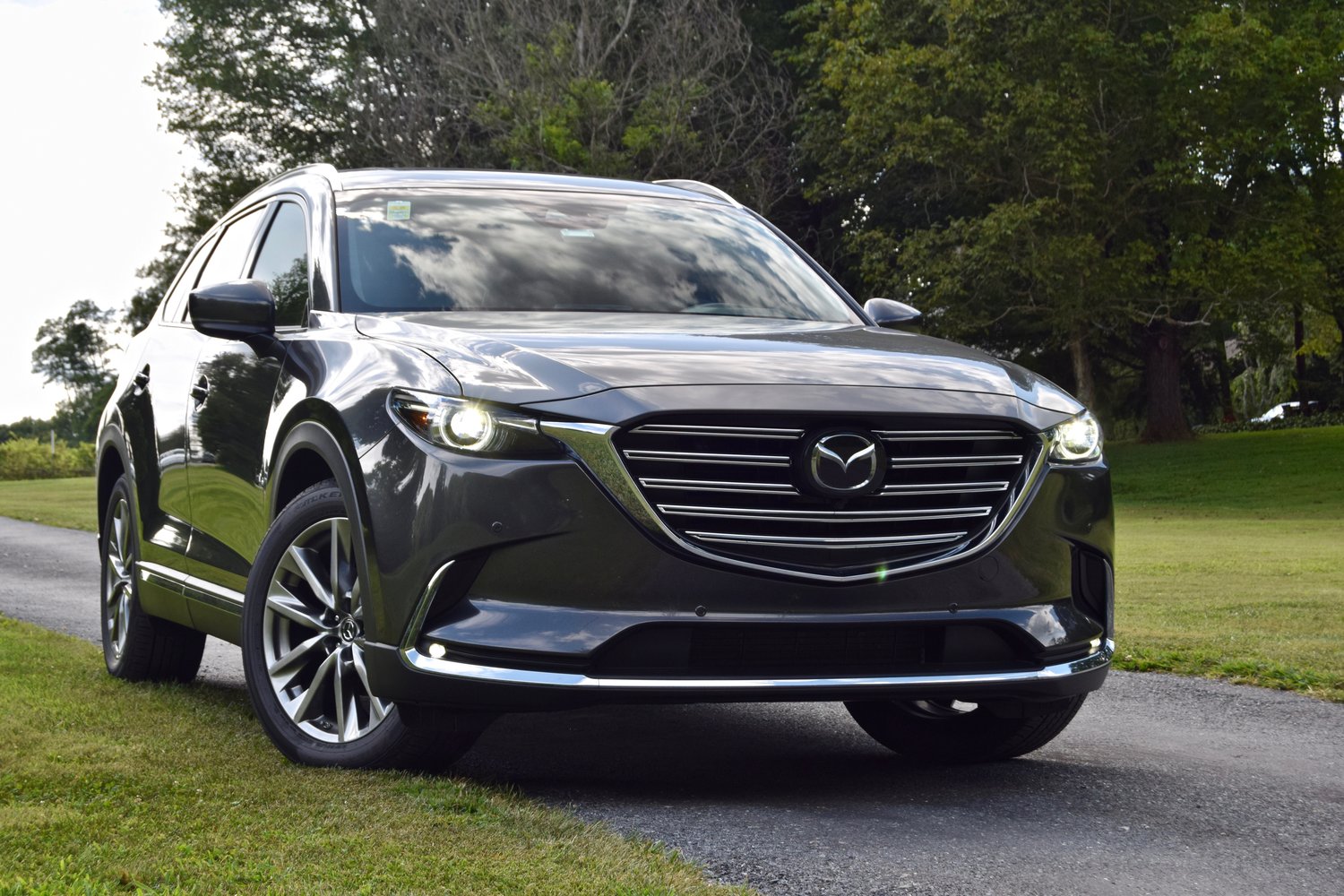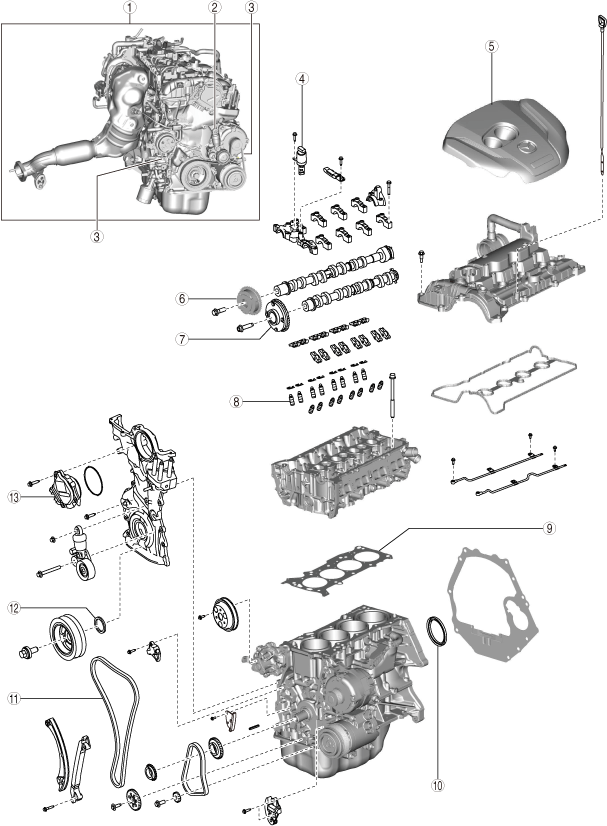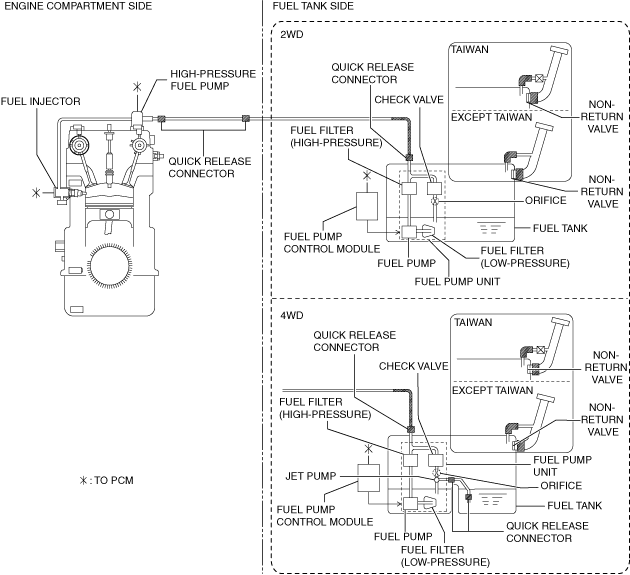
2016 CX9 TC Mazda Electronic Service Information (MESI)
Electronic Manual Coverage:
ENGINE LOCATION INDEX [SKYACTIV-G 2.5T]

ENGINE TECHNICAL DATA [SKYACTIV-G 2.5T]
id0150g5800100
|
Item |
Specification |
|---|---|
|
Idle speed (P position or N position) |
650—750 rpm |
|
Ignition timing |
Approx. BTDC 21° |
|
CO concentration |
Within the regulation |
|
HC concentration |
Within the regulation |
|
Idle-up speed (P position or N position) |
A/C on: 650—800 rpm
Electrical loads on: 650—800 rpm |
|
OCV coil resistance |
6.9—7.55 ohms [20°C {68°F}] |
|
Cylinder head bolt length L |
145.2—145.8 mm {5.717—5.740 in} |
|
Cylinder head bolt length L maximum |
146.5 mm {5.767 in} |
|
Front oil seal press on amount |
0—1.0 mm {0—0.039 in} |
|
Rear oil seal press on amount |
0—0.5 mm {0—0.019 in} |
|
Engine oil capacity (approx. quantity) |
Oil replacement: 4.6 L {4.9 US qt, 4.0 Imp qt}
Oil and oil filter replacement: 4.8 L {5.1 US qt, 4.2 Imp qt}
Total (dry engine): 5.9 L {6.2 US qt, 5.2 Imp qt} |
|
Oil pressure (reference value) [oil temperature: 80—90 °C {176—194 °F}, coolant temperature: 80—90 °C {176—194 °F}] |
Lo: 135—165 kPa {1.38—1.68 kgf/cm2, 19.6—23.9 psi} [1,500 rpm]
Hi: 225—275 kPa {2.30—2.80 kgf/cm2, 32.7—39.8 psi} [4,500 rpm] |
|
Cooling system cap valve opening pressure |
93.2—122.6 kPa {0.951—1.250 kgf/cm2, 13.6—17.7 psi} |
|
Thermostat initial-opening temperature |
Australian specs.: 86.5—89.5 °C {188—193 °F}
Except Australian specs.: 80.5—83.5 °C {177—182 °F} |
|
Thermostat full-open temperature |
Australian specs.: 100 °C {212 °F}
Except Australian specs.: 95 °C {203 °F} |
|
Thermostat full-open lift |
8.5 mm {0.33 in} or more |
|
Throttle body resistance |
0.3—100 ohms [20 °C {68 °F}] |
|
Air bypass valve resistance |
12.7—13.7 ohms [23 °C {73 °F}] |
|
Fuel pressure |
545—695 kPa {5.56—7.08 kgf/cm2, 79.1—100.0 psi} |
|
Fuel hold pressure |
175—326 kPa {1.79—3.32 kgf/cm2, 25.4—47.2 psi} |
|
Fuel injector resistance |
1.6—2.52 ohms [Surrounding temperature: 0—80 °C {32—176 °F}] |
|
Battery electrolyte specific gravity (Without i-stop) |
1.22—1.29 [20 °C {68 °F}] |
|
Battery load test current |
55D23L (60 A·h/20HR): 180 A
75D23L (65 A·h/20HR): 195 A |
|
Parasitic draw (When the ignition is off, all doors and the bonnet are closed.) |
Without i-ELOOP: 10—30 mA
With i-EOOP: 25—45 mA |
|
Battery slow charge current (without i-stop) |
55D23L (55 A·h/20HR): 4.5—5.5 A
75D23L (65 A·h/20HR): 5.0—6.0 A |
|
Battery quick charge current [30 min] (without i-stop) |
55D23L (55 A·h/20HR): 30 A
75D23L (65 A·h/20HR): 35 A |
|
Generator standard voltage [IG-ON] |
Terminal 1A: B+
Terminal 2A: Approx. 1 V or less
Terminal 2B: Approx. 0 V |
|
Generator standard voltage [Idle, 20 °C {68 °F}] |
Terminal 1A: 13—15 V
Terminal 2A: Approx. 3—8 V
Terminal 2B: Turn the electrical loads (such as headlights, blower motor, rear window defogger, brake lights) on and verify that the voltage reading increases. |
|
Generator generated current minimum value |
70% of the nominal output current (nominal output current: 100 A)
[Ambient temp. 20 °C {68 °F}, voltage 13.0—15.0 V, both engine and generator are hot] |
|
Generator rotor resistance (between slip rings) [20 °C {68 °F}] |
1.8—2.1 ohms |
|
Generator brush length |
Standard: 22.5 mm {0.886 in}
Minimum: 5.0 mm {0.20 in} |
|
Generator brush spring force |
Standard: 4.1—5.3 N {0.42—0.54 kgf, 1.0—1.1 lbf}
Minimum: 1.7 N {0.17 kgf, 0.38 lbf} |
|
Firing order |
1—3—4—2 (all cylinders independent firing) |
 |
|
|
Spark plug type |
PY8V-18-110 |
|
Spark plug gap |
Standard: 0.70—0.85 mm {0.028—0.033 in}
New spark plug (reference): 0.70—0.80mm {0.028—0.031 in} |
|
Spark plug resistance [25°C {77 °F}] |
3.0—7.5 kilohms |
|
Starter no-load test voltage |
11 V |
|
Starter no-load test current |
90 A or less |
|
Starter pinion gap (without i-stop) |
0.5—2.0 mm {0.02—0.07 in} |
|
Starter armature runout (without i-stop) |
0.1 mm {0.004 in} max. |
|
Starter commutator diameter (without i-stop) |
Standard: 29.4 mm {1.16 in}
Minimum: 28.8 mm {1.13 in} |
|
Segment groove depth of starter commutator (without i-stop) |
Standard: 0.5 mm {0.02 in}
Minimum: 0.2 mm {0.008 in} |
|
Starter brush length (without i-stop) |
Standard: 12.3 mm {0.484 in}
Minimum: 5.5 mm {0.22 in} |
|
Starter brush spring force (without i-stop) |
Standard: 15.0—20.4 N {1.53—2.08 kgf, 3.38—4.58 lbf}
Minimum: 2.75 N {0.280 kgf, 0.618 lbf} |
FUEL SYSTEM FLOW DIAGRAM [SKYACTIV-G 2.5T]

SYMPTOM DIAGNOSTIC INDEX [SKYACTIV-G 2.5T]
id0103q4800500
Diagnostic Index
|
No. |
TROUBLESHOOTING ITEM |
DESCRIPTION |
|
|---|---|---|---|
|
1 |
Blown fuses |
— |
|
|
2 |
Check engine light illuminates |
• Check engine light illuminates incorrectly. |
|
|
3 |
Will not crank |
• Starter does not work. |
|
|
4 |
Hard to start/long crank/erratic start/erratic crank |
• Starter cranks engine at normal speed but engine requires excessive cranking time before starting.
• Battery is operating normally. |
|
|
5 |
Engine stalls |
After start/at idle |
• Engine stops unexpectedly at idle, after start, or both. |
|
6 |
Cranks normally but will not start |
• Starter cranks engine at normal speed but engine will not run.
• Refer to symptom troubleshooting “NO.5 ENGINE STALLS-AFTER START/AT IDLE” if this symptom appears after engine stalls.
• Fuel is in tank.
• Battery is in normal condition. |
|
|
7 |
Engine oil warning light illuminated/message related to engine hydraulic pressure malfunction indicated in display |
• Engine oil warning light illuminated.
• Master warning light illuminated.
• Message related to engine hydraulic pressure malfunction indicated in display. |
|
|
8 |
Engine runs rough/rolling idle |
• Engine speed fluctuates between specified idle speed and lower speed and, engine shakes excessively.
• Idle speed is too slow and engine shakes excessively. |
|
|
9 |
Fast idle/runs on |
• Engine speed continues at fast idle after warm-up.
• Engine runs after ignition is switched off. |
|
|
10 |
Low idle/stalls during deceleration |
• Engine stops unexpectedly at beginning of deceleration or recovery from deceleration. |
|
|
11 |
Engine stalls/quits |
Acceleration/cruise |
• Engine stops unexpectedly at beginning of acceleration or during acceleration.
• Engine stops unexpectedly while cruising. |
|
Engine runs rough |
Acceleration/cruise |
• Engine speed fluctuates during acceleration or cruising. |
|
|
Misses |
Acceleration/cruise |
• Engine misses during acceleration or cruising. |
|
|
Buck/jerk |
Acceleration/cruise/deceleration |
• Vehicle bucks/jerks during acceleration, cruising, or deceleration. |
|
|
Hesitation/stumble |
Acceleration |
• Momentary pause at beginning of acceleration or during acceleration. |
|
|
Surges |
Acceleration/cruise |
• Momentary minor irregularity in engine output. |
|
|
12 |
Lack/loss of power |
Acceleration/cruise |
• Performance is poor under load. (e.g., power down when climbing hills) |
|
13 |
Knocking/pinging |
Acceleration/cruise |
• Abnormal combustion occurs under the condition such as the temperature in the combustion chamber is too high resulting in abnormal noise.
• Knocking sound occurs from the engine compartment during acceleration. |
|
14 |
Poor fuel economy |
• The fuel consumption is high compared to the customer’s expectations or the previous fuel consumption. |
|
|
15 |
Emission compliance |
• Fails emissions test. |
|
|
16 |
High oil consumption/leakage |
• Oil consumption is excessive. |
|
|
17 |
Cooling system concerns |
Overheating |
• Engine runs at higher than normal temperature/overheats. |
|
18 |
Cooling system concerns |
Runs cold |
• Engine does not reach normal operating temperature. |
|
19 |
Exhaust smoke |
• Blue, black, or white smoke from exhaust system. |
|
|
20 |
Fuel odor (in engine compartment) |
• Gasoline fuel smell or visible leakage. |
|
|
21 |
Engine noise |
• Engine noise from under bonnet. |
|
|
22 |
Vibration concerns (engine) |
• Vibration from under bonnet or driveline. |
|
|
23 |
A/C does not work sufficiently |
• A/C compressor magnetic clutch does not engage when A/C switch is turned on. |
|
|
24 |
A/C is always on or A/C compressor runs continuously |
• A/C compressor magnetic clutch does not disengage. |
|
|
25 |
Sulfuric smell occurs |
• Rotten egg smell (sulphur) from exhaust. |
|
|
26 |
Spark plug condition |
• Incorrect spark plug condition. |
|